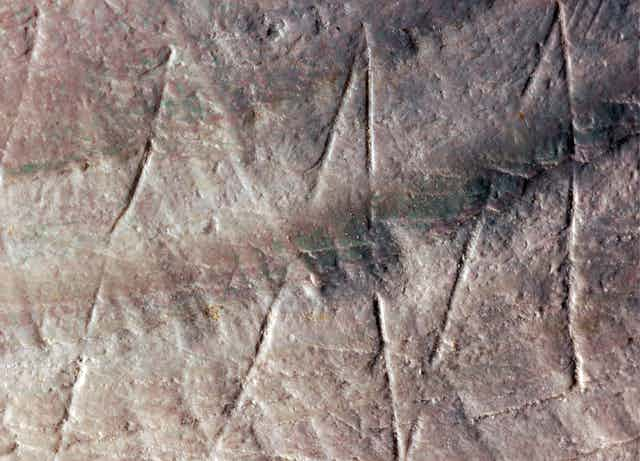Zig-zag markings have been discovered on a shell found at Trinil in Java that dates back to between 430,000 and 540,000 years ago, from the site where the original specimens of Homo erectus were found.
The sensational find, published in Nature today, moves credible arguments for modern human behaviour back in time and suggests it was practised by an even older species of human ancestor. It also shifts the focus firmly outside Africa and Europe.
Has the still-accepted view of human evolution been biased by preconceptions arising from the interpretation of the 19th century finds in Europe?
Homo erectus is well-known to the public as “Java Man” from Indonesia – the species likely responsible for this find – and “Peking Man” from Zhoukoudien, in northern China.
Homo erectus was originally found at Trinil, and the shell find in today’s publication was recovered during the excavation campaigns around that original discovery in the 1890s.
Although there are the usual debates about how ancestral human species should be identified from skeletal remains from the last 3-million years, there is general agreement that something like Homo erectus was one of the earliest species in Africa to be a certain ancestor of other species of humans, including ourselves, from about 1.89-million years ago.
Long before Neanderthals emerged in Europe, or modern humans left Africa, ultimately to colonise Australia and the Americas, Homo erectus also left Africa and reached Dmanisi in Georgia (1.77-million years ago), Java (1.5-million years ago), northern China (700,000 years ago) and probably Europe (900,000 years ago, although European workers tend to use different names for the species there).
What is the new claim?
The authors of today’s Nature publication have demonstrated by careful analysis that the shells from the site, which were all mature animals, date from about 500,000 years ago using two independent methods.

Many of the shells have been punctured at a position which would have allowed the easy opening of the shell to extract the animal as food. In addition, one shell has scratch marks on it (see top), possibly made by a shark tooth, which include some lines that make an M-shaped zig-zag.
The shell also carries other scratches that are not so clearly patterned.
The search for patterned marks has become a major feature of the study of the emergence of modern human behaviour.
The authors point out that this marking is at least 300,000 years older than any other agreed piece.
They discount some scratched bones from Bilzingsleben, in Germany, partly on the grounds that I pointed out back in 1990 that it was unclear that these marks had not been made either by meat stripping or by the actions of the teeth of carnivores which had left distinctive tooth and gnawing marks on the bone.
The best documented examples of earliest objects with scratched patterns are the ochre pieces from Blombos, in South Africa, dated to 73,000 years ago. At Blombos, as at Bilzinglseben, there were many scratched objects (going back to 100,000 years at Blombos) and only a few that had a clear pattern.

Given the presence of both patterned and unpatterned scratches on the Trinil shell, it may be that here, as elsewhere, the scratching was related to something like getting food from the shell. It is only because we are modern people that we see the pattern. It might not have been intended.
What do the scratch marks mean?
So why are shells, and scratches on shells, features associated with modern human behaviour? Three features of this find are exciting for specialists in the emergence of people like us.
First, claims that people extracted food from fish or shell-fish are generally rare for sites left by early ancestors of humans, so the presence of large numbers of shells selected to be the big ones suggests that there may have been shell-fishing much earlier than has generally been accepted.
Second, that there may have been patterned and apparently knowledgeable processing to extract the meat would be a further indication that these creatures knew what they were doing.
Thirdly, making marks that were apparently meaningless, but nevertheless patterned is something that looks as if it is on the way to symbolic use of marks.
What is required for such a pattern to be given meaning – to become symbolic – is that it be repeated. That is the case at Blombos, but it is not here, in Gibraltar, or at Bilzingsleben.
Nevertheless, this find gets closer than other early claims because of the association with apparently knowledgeable exploitation of the shell-fish.
So what does this tell us about our understanding of early humans as these markings pre-date any other discovery?
Not the least of the important aspects of this find is that it was made looking at materials from excavations of the 1890s. At the time, no one expected that very old ancestors of humans might have behaved as modern humans did, in consequence excavators may have overlooked materials that would alter the dominant view that had been formed in the 19th century.
The hunt is now on to look at old collections and re-assess them.
On to Australia
Finally, this find was made in an island that was a stepping stone to Australia.
It has always been one of my arguments about modern human behaviour that Homo erectus was there for more than a million years without ever crossing the seas to Australia, just as the species was in China for a similar length of time without crossing Bering Strait to the Americas.
It still seems that Homo erectus lacked a certain cognitive ability to cross the seas or to survive in the Arctic, but if more finds emerge like this one, we might have to envisage quite different aspects of the past. These are exciting times.

